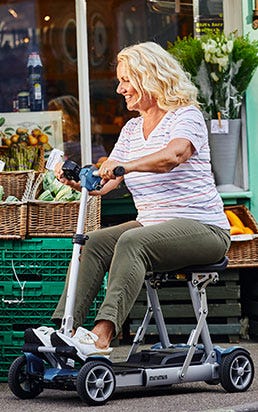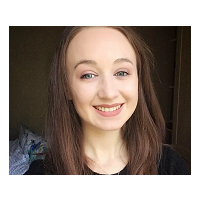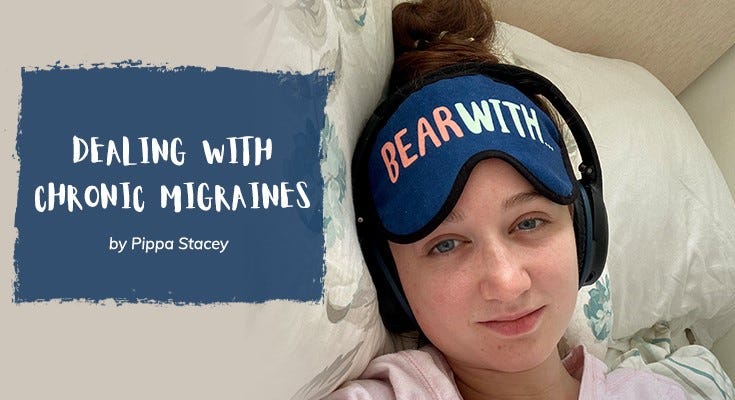Back in 2016, I experienced around four months of chronic migraines. Those four months gave me some of the most debilitating pain I’ve ever had to endure. From October 2016 through to around January 2017, there were only six days out of those entire four months where I wasn’t suffering with a migraine. I wouldn’t wish migraines, let along chronic migraines, on anybody.
I hope with everything in me that the experiences I’m sharing today were a one-time occasion to reflect back on, rather than something that’ll come back in the future, and my heart goes out to anybody dealing with this condition over the longer term. Before I share my own story, I want to acknowledge that dealing with any kind of long-term condition will look different for everybody.
There’s so much value in hearing the experiences of others, but my best advice to anybody who’s experiencing migraines (chronic, episodic, or otherwise) is to reach out for support. Talk to your GP about a referral to a migraine clinic or neurologist, and reach out to organisations such as The Migraine Trust to access support and advice. You don’t have to deal with this alone.
Before 2016, and even before I became chronically ill, I was no stranger to migraines. They run in my family, and I had a very clear understanding of what a migraine was and what it might feel like even before I had experienced them myself. I only had migraines in this traditional sense very occasionally, but one of my primary symptoms when I first became unwell with ME/CFS was debilitating head pain.
When trying to describe this head pain in a way that feels accurate, something I’ve come back to time and time again is the rather unconventional story of Phineas Gage – a name that’ll probably ring a bell if you’ve ever studied psychology. Phineas Gage was a poor old chap who survived a horrific accident during his railroad construction job in the 1840s: an iron rod punctured his cheek, went through his upper jaw and behind his left eye, and came out the other side of his skull through the frontal bone.
Now, obviously it’s a stretch to compare a first-world adult female’s experiences of chronic migraines to one of the most horrific case studies in biopsychology, but to-date, imagining a long iron rod tearing through different parts of my head and face and coming straight out the other side feels like one of the most accurate descriptions I can offer for what this pain feels like. Utterly debilitating.
Throughout my teenage years, I experienced this head pain more and more frequently. I’d flagged it a few times with my GP, and when it began to affect me more days than it didn’t, I was referred to a neurologist. It was only then that I learned these pains I was experiencing were actually migraines too. I didn’t have the ‘aura’ stage that around a third of people with migraines go through, but everything else remained a constant – I would feel a deep, pulsating pain towards the front of the left side of my head, made worse by any movement or sensation, including changes in light or noise.
I wouldn’t be able to read, or look at a screen, or even think too deeply without worsening the pain, and my eyes would almost feel as though they could no longer process information. Generally, it was difficult to do anything other than lay in a dark room and just…bear it. Concentrate on making it from one moment to the next. These sensations would last for hours or days at a time, and even afterwards I would experience the well-documented ‘hangover’ effect which also reduced my functioning.
A few days later when I’d finally begin to feel a little better, the next migraine would kick in. My entire life had to be adapted to fit around my chronic migraines – not ideal for somebody who had just started studying for their postgraduate degree. I’d wake up from unrefreshing sleep, dose myself up on prescription painkillers and then get through as much work as I could possibly fit in two hours, before crawling back into bed and spending the rest of the day recovering. It was utterly unsustainable, and it took some sombre words from my GP and the neurologist to make me see that changes had to be made.
As I mentioned, condition management is incredibly unique and I would always recommend seeking professional advice before adapting your own lifestyle, but here are some of the changes I made to get my chronic migraines under control:
Pain Management
I was prescribed a triptan drug for migraine prevention and NSAIDs (anti-inflammatory medication) to manage pain for if or when it hit. I also benefitted hugely from hot and cold therapy - having something warm on the pressure points at the back of my neck, such as wheat warmers, gave me a surprising amount of relief.
Tracking my symptoms
Keeping notes and recording what I was experiencing helped my neurologist (and later my occupational therapist!) to identify patterns to my migraine onset and pain levels.
Seeing my experiences written down helped me to adapt my pacing strategies for my workload, and even identify foods in my diet that were causing my pain to spike.
It also led to some really interesting reading about the bizarre role of caffeine in headaches and migraines: I put the kettle on far less frequently (not a small feat, if you know me at all), but found that small amounts of caffeine in my essential cups of tea actually had a positive effect in certain situations.
Managing stress
I’ve never been particularly affected by stress, but chronic migraines led to a bit of a vicious circle effect – I was so worried about keeping on top of work and my commitments whilst knowing this horrific head pain could strike at any moment that it actually caused even more migraines than I would have had otherwise.
It took a lot of patience and support from my family and close friends to break me out of this one, but learning to look at the bigger picture and not beat myself up too much when I couldn’t get things done helped me to get on top of everything again.
I had to learn the hard way that worrying about my health and putting pressure on myself was hindering me, not helping me.
Regulating my sleep schedule
I’ve suffered with insomnia and sleep disturbance for years, and though I felt relief from my migraines after I’d had a restful sleep, achieving that restful sleep was in itself a challenge.
However, being conscious of my circadian rhythm by having natural light come into my room whenever I could bear it and utilising a SAD lamp when I felt well enough to have it switched on (pointed well away from my line of vision so the bright light didn’t hurt too badly!) helped me to keep on top of my sleep schedule over the longer-term, even when I needed to nap during the day.
Something else I hugely benefitted from was my electric adjustable bed – being able to prop myself even slightly up often reduced the ‘pressure’ sensation in my head and helped me feel less nauseous than when I was lying down flat, allowing me to rest more comfortably.
If you don’t have an adjustable bed, tactically-placed pillow supports could have a similar positive effect.
Though I still live with frequent head pain as part of my condition, I’m so grateful to have come out of the other side of my chronic migraines – hopefully for good. If you can in any way relate to my experiences, my best advice would be to seek professional help, consider lifestyle adjustments and adaptive equipment that could help you feel more comfortable, and cut yourself some slack. You’re doing the best you can, and you will get through this.


 Price Match Promise
Price Match Promise
 Next day delivery, 7 days a week
Next day delivery, 7 days a week
 Nationwide Showrooms
Nationwide Showrooms
 Rated Excellent
Rated Excellent







